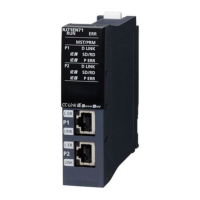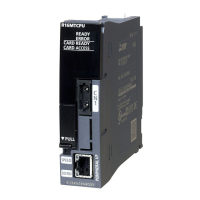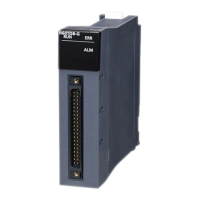80
3 EtherNet/IP Configuration Tool
3.1 Window Structure
• "General" window
Item Description Setting range
Connection No. Displays the connection number of the EtherNet/IP device.
Connection numbers of EtherNet/IP devices are assigned from 1 in the
order in which they were added.
Time-out Multiplier Specifies the monitoring time of the send/receive timeout as an RPI
multiple.
(Monitoring time of send/receive timeout = "Request Packet Interval (RPI)"
× "Time-out Multiplier")
Set the monitoring time of send/receive timeout to 4294967ms or below.
• When "Time-out Multiplier" is set to "×4", set "Request Packet Interval
(RPI)" to "60000" or below.
• When "Time-out Multiplier" is set to "×512", set "Request Packet Interval
(RPI)" to "8388" or below.
• × 4
• × 8
• × 16
• × 32
• × 64
• × 128
• × 256
• × 512
(Default: Varies depending on the
EtherNet/IP device)
Input - T->O Input Size Specifies the size of the input data. (Unit: Bytes)
*1
1 to 1444
(Default: Varies depending on the
EtherNet/IP device)
Input Mode Specifies the target to read the input data from.
• Point to Point: Unicast (one to one) communications are performed.
• Multicast: Multicast (one to many) communications are performed.
• Null: Communications are not performed.
• Point to Point
• Multicast
•Null
(Default: Varies depending on the
EtherNet/IP device)
Input Type Specifies the input type (variable or fixed) according to the size of the input
data.
• Variable: Communications are performed with a variable size.
*2
• Fixed: Communications are performed with a fixed size.
• Variable
•Fixed
(Default: Varies depending on the
EtherNet/IP device)
Priority Specifies the priority of the communication packet for the currently set
connection.
• High: Processing is performed with high priority.
• Low: Priority is given to the processing of connections set to "High".
• Scheduled: Packets are processed in the receiving order regardless of
priority.
•High
•Low
• Scheduled
(Default: Varies depending on the
EtherNet/IP device)
Trigger Type Specifies the trigger type (reading timing) of the input data.
• Cyclic: Triggers are executed periodically according to the "RPI" setting
value.
• Application: Triggers are executed with arbitrary timing according to
'Application Trigger Request (Class1)' (Un\G27008 to Un\G27023).
• Change of State: Triggers are executed at a given timing according to
'Application Trigger Request (Class1)' (Un\G27008 to Un\G27023).
• Cyclic
• Application
• Change of State
(Default: Varies depending on the
EtherNet/IP device)
Inhibit Time Mode Specifies the method to manage the inhibit time when "Trigger Type" is set
to "Change of State".
• Default: A quarter of RPI is specified as the inhibit time.
• Un-Activated: No inhibit time is specified.
• Custom: Time specified in "Inhibit time" is specified as the inhibit time.
•Default
• Un-Activated
•Custom
(Default: Varies depending on the
EtherNet/IP device)
Inhibit time Specifies the inhibit time when "Inhibit Time Mode" is set to "Custom".
(Unit: ms)
1 to 255
(Default: Varies depending on the
EtherNet/IP device)
Request Packet
Interval(RPI)
Specifies the communication cycle. (Unit: ms) 0.5 to 60000
(Default: Varies depending on the
EtherNet/IP device)

